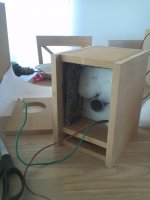Hi guys
I've just finished a pair of small desktop speakers with the driver Monacor SPH-30X.
This little 3" full range has gotten some pretty good reviews and I must say it sounds promising and with surprisingly good bass.
Although it sounds promising the frequency response reveals that the sound can probably be improved even more. See the attached graph(s).
Before measuring the response I would have guessed that a strong notch around 10khz and then some baffle step attenuation would have done the trick, but since it has a dip around 3 khz that I dont want any deeper i'm now leaning towards multiple notch filters.
The solution I have so far includes 3 notch filters, but since two of them deals with the dip at 10 khz, maybe it can be done more effectively. I'm hoping that some of you guys will take a look and tell me what you think
I've uploaded my frequency and impedance measurement, but also the lspCAD project file, and REW measurements to my site:
https://www.sites.google.com/site/diyloudspeakerprojects/home/sph-30x-8-fullrange
Please note that the site is kinda outdated and not really finished, so its not allowed to look around
Regards
Peter
I've just finished a pair of small desktop speakers with the driver Monacor SPH-30X.
This little 3" full range has gotten some pretty good reviews and I must say it sounds promising and with surprisingly good bass.
Although it sounds promising the frequency response reveals that the sound can probably be improved even more. See the attached graph(s).
Before measuring the response I would have guessed that a strong notch around 10khz and then some baffle step attenuation would have done the trick, but since it has a dip around 3 khz that I dont want any deeper i'm now leaning towards multiple notch filters.
The solution I have so far includes 3 notch filters, but since two of them deals with the dip at 10 khz, maybe it can be done more effectively. I'm hoping that some of you guys will take a look and tell me what you think
I've uploaded my frequency and impedance measurement, but also the lspCAD project file, and REW measurements to my site:
https://www.sites.google.com/site/diyloudspeakerprojects/home/sph-30x-8-fullrange
Please note that the site is kinda outdated and not really finished, so its not allowed to look around
Regards
Peter
Attachments
-
 IMG_20130326_143252.jpg448.1 KB · Views: 523
IMG_20130326_143252.jpg448.1 KB · Views: 523 -
 IMG_20130327_131406.jpg348.2 KB · Views: 455
IMG_20130327_131406.jpg348.2 KB · Views: 455 -
 IMG_20130329_161202.jpg558.6 KB · Views: 478
IMG_20130329_161202.jpg558.6 KB · Views: 478 -
 IMG_20130329_182325.jpg250 KB · Views: 446
IMG_20130329_182325.jpg250 KB · Views: 446 -
 IMG_20130421_161507.jpg368 KB · Views: 479
IMG_20130421_161507.jpg368 KB · Views: 479 -
 SPH-30X_lspCAD.png57.8 KB · Views: 295
SPH-30X_lspCAD.png57.8 KB · Views: 295 -
 SPH-30X_frequency_resp.png301.9 KB · Views: 225
SPH-30X_frequency_resp.png301.9 KB · Views: 225
My first reaction would be DSP. I am thinking you could shelve the response (down) from about 400 Hz to 2.5 kHz, then from 2.5 kHz to 3 kHz (up). Then you are left with that 10 kHz peak to sort out with a notch. Maybe you can do the same thing with analog networks, I wouldn't know. DSP was a step to avoid learning analog stuff. I haven't regretted it. 
Thank you 
Well i have thought about digital signal processing, but i dont have much experience in that field. How is that easily implemented? The idea of these speakers, being desktop speakers, was also the possibility of playing music via an ipod and a cheap class d amp.
I already have some of the filter components, so i think i will try to do it passively, but i can imagine that it would be easier to do digitally..
Well i have thought about digital signal processing, but i dont have much experience in that field. How is that easily implemented? The idea of these speakers, being desktop speakers, was also the possibility of playing music via an ipod and a cheap class d amp.
I already have some of the filter components, so i think i will try to do it passively, but i can imagine that it would be easier to do digitally..
If anyone is interested I have now built the (triple!) notch filter. I used components that i had just laying around, but the impact was minor.. Anyways, I think it looks very promising, but I still haven't done any listening tests 
Below are pictures of the simulated effect and the actual measured effect of the notch filter (looks surprisingly alike imo)
Below are pictures of the simulated effect and the actual measured effect of the notch filter (looks surprisingly alike imo)
Attachments
I've built these speaker drivers in many different boxes and have a couple of correction filter options that work well with them, if you're interested I could dig them up...
Megamini the active little beast
41Hz Audio - Megamini the active little beast
Mini Boombox based on my "Macaroni" speaker
41Hz Audio - My new gem
Megamini the active little beast
41Hz Audio - Megamini the active little beast
Mini Boombox based on my "Macaroni" speaker
41Hz Audio - My new gem
- Status
- This old topic is closed. If you want to reopen this topic, contact a moderator using the "Report Post" button.
- Home
- Loudspeakers
- Full Range
- Project SPH-30X/8

